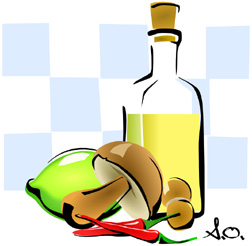
Mass theft and piracy. Outrageous displays of extravagance! There are few bad behaviours that saffron hasn't inspired throughout its 3,000-year history.
Yes, if ever there was a spice that sank a thousand ships, it would be saffron, the dried stigmas of the flowering crocus plant, Crocus savitus.
Cleopatra scented her baths with saffron, thinking it enhanced sexual pleasure. The emperor Nero, in one of his many mad displays of decadence, ordered that the streets of Rome be strewn with it when he entered the city. Saffron has also been long renowned for its medicinal properties. When one shipment worth at least $500,000 in today's dollars was stolen from Rhodes during the plague years, the theft caused a 14-week war!
Saffron is still the world's most expensive spice. Its collection has so far defied automation, so it's still hand-picked from ancient fields in Spain where the best saffron is said to come, and Iran, Greece, Italy and other parts of the Mediterranean. Considering that one flower yields only three threads, and that about 500 threads make up a gram, it's no wonder that half a gram costs about two dollars.
Most dishes that use saffron only call for a pinch, about 20 threads. It's excellent in rice dishes, such as paella or seafood risotto. I also make a shrimp linguine that calls for it. (I'll post links to these recipes soon.)
The best way to prepare saffron is to soak it in liquid — stock, wine or water — for about five to 10 minutes. It will turn bright yellow-orange, at which point you can add the infusion to your dish.
Just don't use too much! Saffron is dangerous in large amounts — five to 10 grams can be toxic to the central nervous system, and amounts beyond that are lethal. Thankfully, its shocking cost prohibits most people from tossing in huge amounts during cooking.
Lastly, beware of cheap imitations! Safflower, or American saffron, for example, comes from an aster family native to the Mediterranean. It looks like real saffron and may cost as much, but it's flavourless, scentless and used mainly as a dye.
Monday, February 18, 2008
History Bites: Saffron
Subscribe to:
Post Comments (Atom)









0 comments:
Post a Comment